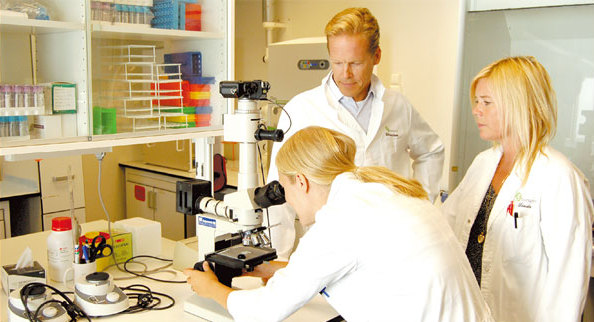Innovative coating makes hospitals better, healthier
Bactiguard started in 2005 with one mission: to reduce hospital-acquired infections transmitted through medical devices.
Its innovative technology is based on the Swedish industrialist Gustaf Daln's Nobel Prize-winning research from 1912, on automatic regulators for use in conjunction with gas accumulators to illuminate lighthouses and buoys.
Christian Kinch, founder and CEO of Bactiguard, founded the company after meeting the inventor Billy Sdervall.
|
Linda Persson, molecular biologist; Christian Kinch, founder and CEO of Bactiguard; Linda Nyberg, vice-president of International Affairs. |
Sdervall had developed Daln's research and produced a unique metal alloy that can be permanently bonded to the surface of any medical accessory - limiting bacterial adhesion and preventing its reproduction.
He is 70 years old this year, and is still very active in Bactiguard.
"Bactiguard's products can reduce HAI by up to 73 percent, according to our latest study," says Kinch.
"Since 1995, over 125 million patients have used catheters coated with Bactiguard's patented technology around the world."
HAI is currently the fourth largest cause of death in the Western world, behind only cardiovascular disease, cancer and strokes.
Bactiguard's technology aims to reduce this significantly, saving lives and healthcare expenses. "If our foley catheters were used in only 50 percent of China's hospitals, it could prevent up to 200,000 urinary tract infections and more than 5,000 related deaths each year, while also saving the Chinese healthcare system over $650 million in costs associated with HAI treatment," he said.
Currently, over 60 percent of HAI around the world is caused by the use of urinary tract catheters, central venous catheters and endotracheal tubes. Bactiguard has all of these three areas covered in its infection protection product portfolio. The potential for its technology is nearly limitless, since the alloy is invisible and permanent: with applications possible on anything from door handles to contact lenses. It is also biocompatible, meaning it is tissue-friendly.
"My job's real reward is knowing that every day we save someone's life by protecting him or her from HAI," says Kinch. "This pushes us to expand our market share to help even more patients. Knowing that we are helping so many individuals is what gets me out of bed every morning."
The use of Bactiguard's infection-preventing products has had another positive side effect: the greatly reduced need for antibiotics.
Modern society's overuse of antibiotics is leading to multi-resistant bacteria that are increasingly immune to many types of treatment.
In fact, the World Health Organization describes microbial resistance as one of the greatest threats to human health today.
Already present in 30 countries around the world, Bactiguard is now introducing its products to the Chinese market. Partnering with the pharmaceutical distributor, Jian An, it aims to tap this huge market through its partner's sales network - with the goal of making its products eventual mainstays in Chinese hospitals.
Kinch understands that China is crucial to Bactiguard's expansion plans, and hopes that bringing Bactiguard's products to a wide section of the Chinese public will benefit even more people than it has already helped so far.
www.bactiguard.com
World Eye Reports provided the story



















